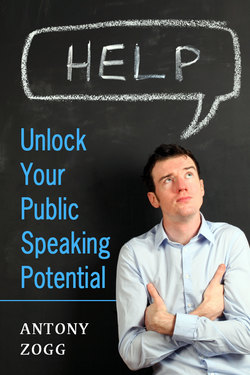Читать книгу Unlock Your Public Speaking Potential - Antony Boone's Zogg - Страница 8
На сайте Литреса книга снята с продажи.
3.3 Visualization
ОглавлениеOnce you have written down your goal, and the reason why you want to achieve it, I want you to find a quiet place where you can daydream a bit and put your imagination to work for you.
At least twice a day, read your goal and your reason for wanting to speak in public. Now lean back in your chair, or relax in bed before turning out the light, close your eyes and take 2 or 3 deep and slow breaths to calm yourself down. In this relaxed state visualize you standing in front of an audience and giving an amazing speech. Be as specific and detailed as you can. If you are planning to speak at a wedding, try to visualize the venue, the smiling guests, the bridal couple, and the wedding cake. See yourself speaking, the audience members nodding and smiling in agreement, see audience members laughing at your humorous anecdotes and see them applauding you on concluding your speech. As you visualize, engage your emotions and feel the excitement and the thrill of speaking, your fondness for the bridal couple and your feeling of exhilaration as you are applauded at the conclusion of your speech. Visualize yourself giving the speech of your life. Read your goals and visualize them daily.
However, there are times while we are visualizing our dreams that we suddenly get a “touch of reality”. A little voice inside of us starts saying things like: “You must be crazy – you will never be a successful public speaker. Remember what happened when you when you tried to speak in public the last time – you forgot your words”. Sadly, for many people, this negative self –talk is enough to convince us not to follow through on our goals and dreams.
There are a variety of alternate treatments for dealing with self doubt, fears, negative emotions and limiting beliefs. I never used these techniques as part of my public speaking journey, as I only discovered them after I had conquered my fear of public speaking. Having discovered these tools somewhat belatedly, I have used them with reasonable success in other areas of my life where I had to neutralize a lot of negative emotions including fear. Based on this experience I can well appreciate that they might be a useful tool in quietening down all of the negative chatter and fear associated with public speaking. You might like to investigate EFT or the Sedona Method. I am not a qualified medical practitioner or psychologist, and I can only let you know that there are alternate therapies that help neutralize fears and lessen limiting beliefs. These therapies have not to my knowledge been subjected to rigorous peer-reviewed academic research, but there are untold numbers of testimonials from people who swear that they actually work. Remember though, that the responsible thing to do is to always check with your medical professional or psychologist before commencing with EFT or any other alternate therapies.
I am sure that these alternate therapies might help in a public speaking context, and if they do, they will compliment your efforts as you read up on public speaking in this e-book, trying new things and getting in as much public speaking practice as you can. Many public speakers I helped over the years became very effective without relying on any sort of alternate therapies. I merely draw your attention to their existence, and it is possible that they may make your journey a lot easier.
